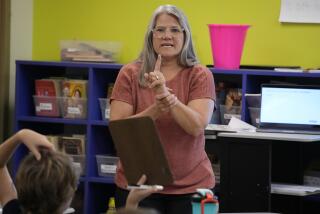Pupils Take New Tack to Reach Old Theorem
- Share via
The Pythagorean theorem has been rediscovered at Mountain View High School in El Monte.
The 30 students who figured out the ancient geometric principle did so on their own--without a textbook, conventional teaching help or any idea of where they were headed.
They were armed only with three geometric facts and a teacher who believes that geometry is the key to thinking, and that most students do not learn how to think.
The students reached the same conclusion that Pythagoras did in the 6th Century B.C.: that the square of the longest side of a right triangle is equal to the sum of the square of the two other sides.
Christopher (Chip) Healy launched the experimental, yearlong class last September. With the approval of the school administration, Healy gave one of his geometry classes the opportunity to try to learn from each other rather than from a textbook.
At the beginning of the class, the students, aged 14 to 18, were told only that “parallel lines never meet,” the angles of “a linear pair” (two lines that are connected, but don’t cross) add up 180 degrees and “the sum of the angles of a triangle is 180 degrees.”
Their exploration of these facts has resulted in a book of their discoveries, right or wrong, that grows daily.
The experiment is being watched and written about by educators across the country. If successful, it could become a model of innovative cooperative education.
“This is so unusual--I have never seen such an engaged group of learners, including the teacher,” said Toby Bornstein, who heads a Los Angeles area high school mathematics program that is part of a nationwide network of schools that are experimenting with teaching innovations.
“Here is a teacher who took the initiative to do something different,” said Norman Webb of the University of Wisconsin, who is reporting on the class in a national study financed by the Ford Foundation.
Healy, 39, said the class grew out of a monthlong program for math teachers last summer at UC Berkeley. He decided to experiment with “cooperative learning,” in which students and teachers create their own programs as they go along.
“Many people have concluded that the most important class a student takes is geometry, because it’s where kids are taught to think,” Healy said. “Having taught geometry out of a traditional text for three years, I knew my students were not necessarily able to think.
Healy placed the students in groups of four that change every two weeks. The students now have 10 typewritten pages of definitions, diagrams and “discovered truths”--their term for theorems. They have examined angles, quadrilaterals and triangles, eventually working their way to the Pythagorean theorem.
Not satisfied, the students then asked, “If you cube the sides of a right triangle, does the theory apply?”
“I’ve never heard that question asked before,” said a delighted Healy, who last weekend shared it with other math teachers in a Southern California workshop. “Now we’ve got a lot of experts working on it.”
Healy said his major role is to bounce the students’ ideas back to them, without telling them if they are right or wrong.
Describing himself as “a guy who would teach even if they don’t pay me--but don’t tell anyone that,” Healy also is a part-time track coach, drama teacher, playwright and father of two little girls.
Said one student, Laura Camarena: “I like this class because we use our imagination, not (only) our brains.”
Melody Saisanith, a freshman at Mountain View High School, contributed to this story as part of a journalism project sponsored by The Times.
THE PYTHAGOREAN THEOREM
Euclid provided a proof of the Pythagorean theorem by showing that the area of a square erected on side A of a right triangle, plus the area of a square erected on side B, was equal to the area of a square erected on side C, the hypotenuse. Thus A2+ B2= C2.
More to Read
Sign up for Essential California
The most important California stories and recommendations in your inbox every morning.
You may occasionally receive promotional content from the Los Angeles Times.













